Neoplan Skyliner
The Neoplan Skyliner is a double-deck multi-axle luxury touring coach built by German coach manufacturer Neoplan. It was introduced in 1964.
| Neoplan Skyliner[1] | |
|---|---|
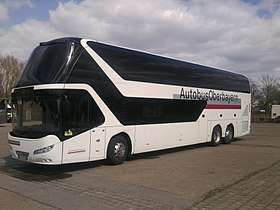 | |
| Overview | |
| Manufacturer | Neoplan Bus GmbH, subsidy of MAN Nutzfahrzeuge AG[2] |
| Production | 1967-present |
| Assembly | Plauen, Saxony, Germany Akyurt, Ankara, Turkey |
| Designer | Konrad Auwärter |
| Body and chassis | |
| Class | Commercial vehicle |
| Body style | Double-deck multi-axle touring coach |
| Layout | Longitudinal rear-engine design |
| Powertrain | |
| Engine | 12.5 L MAN D2676 LOH R6 multi-valve CR turbodiesel[3][4] |
| Transmission | 12-speed TipMatic ZF AS Tronic automated manual |
| Dimensions | |
| Wheelbase | 6,700 and 1,470 mm (263.8 and 57.9 in) |
| Length | 14.00 m (45 ft 11 in) |
| Width | 2.55 m (8 ft 4 in) |
| Height | 4.00 m (13 ft 1 in) |
| Kerb weight | 26,000 kg (57,320 lb) (GVWR) |
History
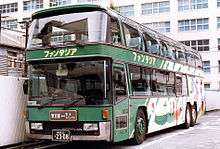
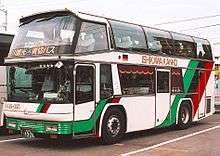
In 1964, the founder's second son, Konrad Auwärter, developed a double-deck design for a service bus as part of his dissertation.[5] The 'Do-Bus' design had extremely low weight, and could carry over 100 passengers.[5] It also featured a low-frame front axle with forward-mounted steering gear that permitted a low flat floor.[5][6] The double-deck principle was applied to coach design, creating a revolutionary high-capacity comfortable vehicle for touring. This vehicle was known as the Skyliner,[7] and created an image for the company that differentiated the Neoplan brand from its competitors, and created interest in its products across Europe.
A second manufacturing facility opened in Pilsting in 1973,[8][9] and a third opening in Kumasi, Ghana, in December 1974[8] to support a large order.[9]
The double-deck Skyliner concept was taken to its ultimate conclusion in 1975, with the introduction of the Jumbocruiser,[9] a double-deck articulated coach 18 metres (59 ft 1 in) long[6][9] and 4 metres (13 ft 1 in) high.[9] The Spaceliner,[10] introduced in 1979 took the Cityliner concept of passenger floor level above the driver, and extended the actual floor above the cab. This kept the height of the vehicle lower than a double-decker, at 3.65 metres (12 ft 0 in), but still allowed installation of toilets, kitchens or sleep cabins below the passenger compartment.[10]
Southern California Rapid Transit District of Los Angeles, operated Neoplan Skyliners during the 1980s and early 1990s. Antelope Valley Transit Authority operated Skyliners on their Lancaster-Los Angeles route during the late 1990s early 2000s.
UK
The Neoplan Skyliner also gained popularity in the United Kingdom. Stagecoach bought some Skyliners during the 1980s to facilitate its new coaching division developed during the company's early years. In 2004, it bought 25 more N122/3L Skyliners for its modern coaching divisions the Oxford Tube and Megabus.[11] Trathens Travel Services of Plymouth also bought some Skyliners in 2005 for its National Express contracts. However, many of these were displaced following the accident with a National Express Skyliner (see below) - when some Plaxton Panthers were bought in 2007.
Specifications (2009)
The Neoplan Skyliner has undergone a process of evolution in specification since its 1964 introduction. As of 2009, the double-deck Skyliner is available in two lengths: the Skyliner C and the Skyliner L.[1] The shorter C version used to be 12.00 metres (39 ft 4 in) long, but is now 12.44 metres (40 ft 10 in); and the Skyliner L is 13.79 metres (45 ft 3 in) long, and includes a correspondingly longer wheelbase.[1] The Skyliner C is designed to seat 69 passengers plus two crew (driver and steward), whereas the Skyliner L seats 77 plus two.[1]
For the powertrain detail, current Skyliners use an MAN diesel engine sourced from Neoplan parent company MAN Nutzfahrzeuge AG. This Euro4 rated diesel fueled internal combustion engine is the 12.5 litre MAN D2676 LOH 02 straight-six (R6) common rail turbodiesel with intercooler, which displaces 12,412 cubic centimetres (757.4 cu in), and utilises four valves per cylinder and cylinder-direct fuel injection.[1][3][4] It uses a Bosch EDC7 electronic engine control unit, and also uses a 'PM-KAT' catalytic converter.[3][4] It produces a DIN-rated motive power output of 353 kilowatts (480 PS; 473 hp) at 1,900 revolutions per minute (rpm), and generates a torque turning force of 2,300 newton metres (1,696 lbf⋅ft) at 1,050-1,400 rpm.[1][3][4] The engine is mounted upright in a longitudinal orientation at the rear of the coach,[1][3][4] and transmits its output to the rear roadwheels via a twelve-speed TipMatic ZF AS Tronic automated manual transmission.[1]
An interesting design on the Skyliner is its 'tag' third axle. This is able to articulate, during steering movements - and this helps reduce tyre wear,[1] which can afflict dual rear axle vehicles. It features disc brakes all round, and utilises independent suspension on the front and trailing third axles, whilst the driven axle is a solid version.[1]
Standard safety features include 'electronically regulated braking system' (EBS) with braking assistant (BA) and Electronic Stability Programme (ESP).[1] It also features a speed-limiting device called 'maximum speed control' (MSC), and is fitted with an accident data recorder (ADR).[1] An optional feature is the 'lane guard system' (LGS), which will vibrate the drivers seat should the coach drift out of its lane.[1]
Its maximum permissible weight is 26,000 kilograms (57,320 lb), and can have a total luggage volume of up to 7.9 cubic metres (279 cu ft).[1]
| model | internal combustion engine | max. power @ rpm | max. torque @ rpm | transmission | wheelbase | length | width | height |
|---|---|---|---|---|---|---|---|---|
| Skyliner C (double-deck multi-axle)[1] | MAN D2676 LOH 02, 12,412 cc (757.4 cu in) R6 common rail turbodiesel | 353 kW (480 PS; 473 hp) @ 1,900 | 2,300 N⋅m (1,696 lbf⋅ft) @ 1,050-1,400 | 12-speed TipMatic ZF AS Tronic automated manual | 5,550 and 1,300 mm (218.5 and 51.2 in) | 12.44 m (40 ft 10 in) | 2.55 m (8 ft 4 in) | 4.00 m (13 ft 1 in) |
| Skyliner L (double-deck multi-axle)[1] | MAN D2676 LOH 02, 12,412 cc (757.4 cu in) R6 common rail turbodiesel | 353 kW (480 PS; 473 hp) @ 1,900 | 2,300 N⋅m (1,696 lbf⋅ft) @ 1,050-1,400 | 12-speed TipMatic ZF AS Tronic automated manual | 6,900 and 1,300 mm (271.7 and 51.2 in) | 13.79 m (45 ft 3 in) | 2.55 m (8 ft 4 in) | 4.00 m (13 ft 1 in) |
Specifications (2017)
The latest generation was introduced in 2011. The Skyliner is now only available in 14.00 m length. The capacity, depending on the comfort level, is 68 to 83 seats.[12]
| model | internal combustion engine | max. power @ rpm | max. torque @ rpm | transmission | wheelbase | length | width | height |
|---|---|---|---|---|---|---|---|---|
| Skyliner (double-deck multi-axle)[1] | MAN D2676 LOH, 12,419 cc (757.9 cu in) R6 common rail turbodiesel | 368 kW (500 PS; 493 hp) @ 1800 | 2,500 N⋅m (1,844 lbf⋅ft) @ 930–1350 | 12-speed TipMatic ZF AS Tronic automated manual | 6,700 and 1,470 mm (263.8 and 57.9 in) | 14.00 m (45 ft 11 in) | 2.55 m (8 ft 4 in) | 4.00 m (13 ft 1 in) |
Accidents
In March 2003 near Nažidla in South Bohemian Region a Neoplan Skyliner overturned on Czech European route E55, killing nineteen people and one man died two years later due to the injuries sustained in the crash.[13] Thirty-four people were injured.[14] It has been the biggest bus accident in history of the Czech Republic.[15]
In May 2003 in France a Neoplan Skyliner overturned on a French highway, killing twenty-eight people.[16] A report by French investigators recommended that drivers of double-deck coaches should receive special training because of the vehicle's relative instability. A separate study, presented to the United Nations Economic Commission for Europe in the same year reported that high-sided coaches were much more likely to overturn in crashes than standard single-deck coaches. The German manufacturer added a safety system, known as electronic stability control, which brakes each wheel separately to prevent overturning in 2006.[17]
In January 2007 a Neoplan Skyliner operated by National Express overturned and crashed on the M25 motorway near Heathrow Airport, killing two passengers;[18] a third passenger died six-months later due to the injuries sustained in the crash.[19] The company temporarily withdrew all twelve Skyliners from service pending investigations[20][21] The crash was deemed to have been caused by travelling at excessive speed and the driver was charged with three counts of causing death by dangerous driving.[22] He was subsequently jailed for five years and banned from driving for three years.[23] No safety issues were found.[24] The electronic stability control system which had been introduced on new vehicles in 2006 was not used on this vehicle.[17]
Gallery
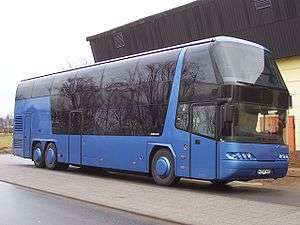 Skyliner N 1122 in Germany
Skyliner N 1122 in Germany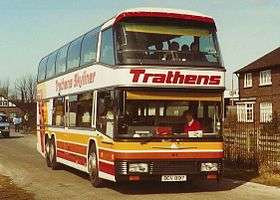
 1996 Skyliner AN122/3 operated by Antelope Valley Transit Authority (ATVA) in Los Angeles
1996 Skyliner AN122/3 operated by Antelope Valley Transit Authority (ATVA) in Los Angeles 2004 Stagecoach Oxfordshire Skyliner operating on the Oxford Tube route
2004 Stagecoach Oxfordshire Skyliner operating on the Oxford Tube route- Rear of Stagecoach Oxfordshire Skyliner operating on the Oxford Tube route
References
- "Neoplan Skyliner" (PDF). MAN Nutzfahrzeuge AG. Neoplan.de. 0908. Retrieved 27 November 2009.
- "The strategy of the Neoplan VIP Class brand". MAN Nutzfahrzeuge Group. Neoplan.de. Retrieved 24 November 2009.
- "MAN D2066, D2676 Common-Rail Euro4 vehicle diesel engines". MAN Nutzfahrzeuge AG. Neoplan.info. Archived from the original on 21 March 2008. Retrieved 1 December 2009.
- "Technical data - Diesel engines for Buses". MAN Nutzfahrzeuge AG. Neoplan.info. Archived from the original (jpg image) on 21 July 2011. Retrieved 1 December 2009.
- "Milestones - History from 1961 to 1964". MAN Nutzfahrzeuge Group. Neoplan.de. Archived from the original on 27 June 2010. Retrieved 24 November 2009.
- "History - The story of Neoplan Bus GmbH". MAN Nutzfahrzeuge Group. Neoplan.de. Archived from the original on 14 February 2010. Retrieved 24 November 2009.
- "Milestones - History from 1965 to 1971". MAN Nutzfahrzeuge Group. Neoplan.de. Retrieved 24 November 2009.
- "Locations - The plants of Neoplan Bus GmbH". MAN Nutzfahrzeuge Group. Neoplan.de. Archived from the original on 27 August 2009. Retrieved 24 November 2009.
- "Milestones - History from 1972 to 1975". MAN Nutzfahrzeuge Group. Neoplan.de. Archived from the original on 27 August 2009. Retrieved 24 November 2009.
- "Milestones - History from 1976 to 1981". MAN Nutzfahrzeuge Group. Neoplan.de. Archived from the original on 27 August 2009. Retrieved 24 November 2009.
- "Stagecoach gets first new skylines | 15 February 1986 | The Commercial Motor Archive". archive.commercialmotor.com. Retrieved 5 September 2017.
- Skyliner brochure, downloaded 2017-09-04
- cs:Nehoda_u_Nažidel, Czech Wikipedia
- "Nineteen dead, 34 injured in horrific bus crash". Český rozhlas. 10 March 2003. Retrieved 6 April 2010.
- "Tragická nehoda autobusu Nažidla 2003". Nažidla 2003. Archived from the original on 10 February 2015. Retrieved 6 April 2010.
- "Profile: Neoplan Skyliner". BBC News. 6 January 2007. Retrieved 24 November 2009.
- Webster, Ben (5 January 2007). "Design inherently unstable, say investigators". The Times. London.
- "Two dead after M-way coach crash". BBC News. 4 January 2007. Retrieved 24 November 2009.
- "Coach crash injuries caused death". BBC News. 20 July 2007. Retrieved 24 November 2009.
- "National Express removes coaches". BBC News. 4 January 2007. Retrieved 25 November 2009.
- "Coach crash firm withdraws buses". BBC News. 4 January 2007. Retrieved 25 November 2009.
- "Coach driver faces death charges". BBC News. 23 July 2007. Retrieved 25 November 2009.
- "M25 coach deaths driver is jailed". BBC News. 26 November 2008. Retrieved 24 November 2009.
- "Coach death driver pleads guilty - No safety problems". BBC News. 15 October 2008. Retrieved 24 November 2009.
External links
| Wikimedia Commons has media related to Neoplan Skyliner. |
- Neoplan Skyliner - official website